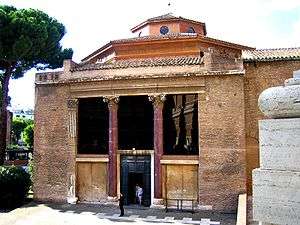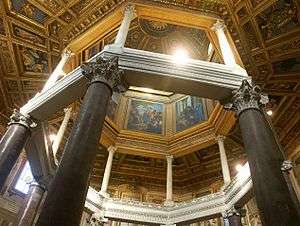Lateran Baptistery
Coordinates: 41°53′10.14″N 12°30′15.44″E / 41.8861500°N 12.5042889°E


The domed octagonal Lateran Baptistery stands somewhat apart from the Basilica di San Giovanni in Laterano, Rome, to which it has become joined by later construction. This baptistery was founded by Pope Sixtus III in 440, perhaps on an earlier structure, for a legend grew up that Constantine the Great had been baptized there and enriched the structure. However it is more likely that if he was baptized it was in the Eastern part of the Roman Empire and possibly by an Arian bishop.[1] This baptistry was for many generations the only baptistery in Rome, and its octagonal structure, centered upon the large octagonal basin for full immersions, provided a model for others throughout Italy, and even an iconic motif of illuminated manuscripts, "The fountain of Life".
Around the central area, where is the basin of the font, an octagon is formed by eight porphyry columns, with marble Corinthian capitals and entablature of classical form. On the ceiling of the Baptistry is the story of the Battle of the Milvian Bridge (312). An ambulatory surrounds the font and outer walls form a larger octagon. Attached to one side, towards the Lateran basilica, is a fine porch with two porphyry columns and richly carved capitals, bases and entablatures.
Its plain brick exterior is embellished with a frieze designed by Francesco Borromini in 1657, incorporating the arms of Pope Alexander VII.
See also
External links
| Wikimedia Commons has media related to Lateran Baptistry (Rome). |
- Battisterio Lateranense; based on Giuseppe Vasi's engravings and his Itinerario 1761.
Citations
- ↑ Head, Thomas, Medieval Hagiography, p. 93, note, 19